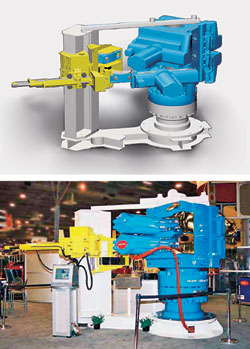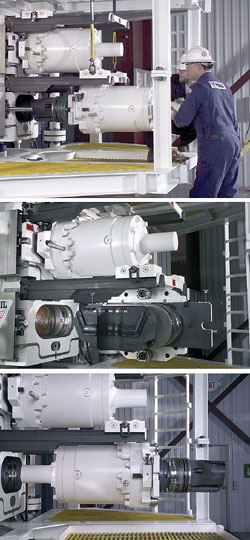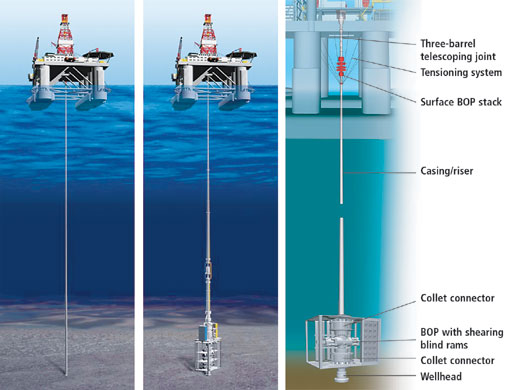Will new BOP designs catch on with operators
Drilling TechnologyWill new BOP designs catch on with operators?While the benefits can be reasoned, it is the rig providers that have to take the initial riskPerry A. Fischer, Editor The world of BOPs – while it does experience change – does not do so as rapidly as some technologies. This is probably because it is such an essential piece of equipment in the drilling process that experimentation is cautious and incremental. So, while size and weight reductions and improvements in materials continue, BOP design is still based on the fundamental principles of the original ram-type BOP. Presented here are the latest offerings from BOP makers Hydril, Varco, and Cameron. Varco and Hydril have recently introduced new versions that emphasize speed and ease of ram inspection and change-out. Whatever the cost for retrofitting an existing rig, it's more likely that new designs will be more economical in newbuilds, where the cost of installing the new technology would not likely add all that much to the daily rate. Just how often a ram door needs to be opened – either for inspection, maintenance or change-out – depends on many factors. If the job calls for a change in drill pipe, a ram change will probably be necessary, although it's possible that, depending on the location and floor height, adding rams to accommodate a planned change in drill pipe might be cost effective. That would certainly be the case on a subsea BOP. But in many cases, in less expensive land drilling environments, the time would simply be allotted to open up the BOP. Also, there is always the unexpected, including a departure from the planned drill pipe schedule or a failed BOP test. One should not forget about routine maintenance and inspection, either. Regardless of when rams are changed – even between jobs when the rig is in transport – quicker and easier ram extraction should still save time, manpower and, especially on a newbuild, money, as well as enhance safety. Here's where it gets a bit sticky. Since BOPs are generally bought by the rig contractor, their cost/ benefit to an oil company can get lost in the daily rate quote. Although the benefits are primarily time savings, even time has a safety aspect. Moreover, by having only two men, as opposed to, say, four, in what is often a difficult workspace, safety should be directly enhanced. Whether lease operators will see enough benefit to pay anything for this safety remains to be seen. But some operators are sufficiently concerned with safety performance that, if these new, quick ram-changing technologies prove safer over time, it could give a contractor the edge. It should be remembered that these BOPs are very new. Thus far, Hydril has one (13-5/8 in.) on order for an as yet unnamed jackup, to be installed later this year, and Varco has not yet sold its first automated ram changer (although it has sold many boltless ram door BOPs). Cameron has not introduced a new BOP design in nine years, unless one counts its subsea ESG single ram. The company does not seem impressed or threatened by its competitors or by boltless-door BOPs. It has an “If it isn't broke, why fix it?” attitude. It continues to have the lion's share of the market; it did, after all, invent the ram type BOP back in 1922. Shaffer (Varco International, Inc.). This company introduced an Automated Ram Changer (ARC*) system about a year ago. The new system is built on the company's NXT* blowout preventers, which were the industry's first boltless door BOPs. The ARC has a ram changing arm that quickly and accurately retrieves and replaces ram blocks from a simple removable ram storage magazine, Fig. 1.
Nearly all hands-on activity in changing rams is eliminated, which should reduce lost time accidents. The company says that the new system, combined with its boltless BOP technology, can reduce ram change time to 36 min. Traditional ram change time is almost four hours. The ARC may even be adapted to an ROV for subsea applications, potentially saving several days of a well program. In addition to the safety and time benefits, manpower requirements can be greatly reduced, at least during ram changing, because just two crewmen are needed instead of the usual four or five. First introduced in the mid-1990s and significantly improved in recent years, the NXT BOP system has heightened competition in the BOP market. By replacing conventional bolts with a lockbar device, the system enables automatic opening and closing of NXT BOP doors. Consequently, the system enhances drilling efficiency, offers significant rig up-time improvements, reduces size and weight and, with less manpower needed, improves safety. It is available in various sizes from 18-3/4 in. (X15M) to 13-5/8 in. (X10M). These BOPs are now widely accepted and used around the world, with an installed base on land, and on offshore platforms, jackups and floating rigs in the Gulf of Mexico, the North Sea, the Caspian Sea and offshore West Africa, China and Venezuela. Hydril. A new BOP design from Hydril called Quik-Loq* also increases safety in a similar manner to the above, by reducing time, manpower and eliminating tools, as well as increasing efficiency by allowing ram/ operator change-out in a matter of minutes rather than hours. Although not an automated system, locking and unlocking the ram operator to the body is done without tools, allowing a “hands clear” environment for convenience and personnel safety. A sliding/ rotating mounting for the ram-operator assembly makes ram change-out safer than with conventional designs. Such ram access makes the lifts associated with such service more simple and straightforward. Locking and unlocking the ram door is performed remotely for convenience and personnel safety. Key to the improved method is a segmented, elliptical lock ring and method of handling the operator assembly. Energized by a linearly stroking actuator ring, a segmented lock ring retracts when the unlock mechanism is hydraulically actuated (i.e., the proprietary quick release blowout preventer bonnet). This allows field personnel to easily roll the operator assembly out of the BOP body on its pivot/ slide mounting, Fig. 2.
Once clear of the body, the operator assembly can be simply rotated by hand to any desired position from 0° to 360° rotation. The pivot point is located at the “average” center of gravity (a point halfway between the centers of gravity with and without the ram block attached) so rotation is easy and free. The operator assembly can be rotated as desired or to detent positions at 90° (four places) to make the ram block easily and safely accessible. It can then be lifted vertically with no interference from an upper operator assembly or other constraint. The new design can be used for surface or subsea drilling. The unit will be offered initially in a 13-5/8 -in. through-bore size rated at 15,000 psig working pressure. Other sizes and pressure ratings will become available in the near future. All designs use the field-tested Hydril Multiple Position Locking (MPL) clutch. Cameron. The company's U series BOPs have been around for decades. Based on that design, the company introduced its TL type BOP in 1991. It's still around, but primarily for the subsea market. For everyday use, clients complained that they had a substantial investment in the U-type rams, and these were not interchangable with the TLs. In response, the company introduced the UM series in 1995. It improved the previous bonnet design, so that a single hydraulic bonnet could be opened/ closed to provide quicker access to rams and some seals. Since then, it has sold about 60 of these worldwide. That was the company's last significant BOP design change. However, the company has a continuing R&D effort into materials, especially elastomerics, and has achieved a 350° temperature rating on some of its BOPs. Cameron does have a new technology – less than three years old – that is in its own class. It's called an ESG, for environmental safe guard. It's a seafloor-positioned shear ram of UM design that is primarily for emergency shear, seal and disconnect from the seabed. This allows a traditional surface BOP stack, suspended below the rig floor, to handle the well control functions. The ESG has a basic control system (acoustic, electric, ROV-actuated, or hydraulic). The subsea portion is tied back to the surface BOP stack via high-pressure riser, a proprietary triple-barrel telescoping joint and a motion-compensation system, Fig. 3. The 10,000-ft, deepwater-capable system extends the weather window and is considerably smaller and lighter than traditional systems, enabling the use of a second or third generation rig, even in deep water. To date, three of these systems have been sold.
The ESG system won a Best Drilling/Completion award from this magazine in 2002, as selected by an independent panel. |
||||||||||||||||
- Coiled tubing drilling’s role in the energy transition (March 2024)
- Using data to create new completion efficiencies (February 2024)
- Digital tool kit enhances real-time decision-making to improve drilling efficiency and performance (February 2024)
- E&P outside the U.S. maintains a disciplined pace (February 2024)
- U.S. operators reduce activity as crude prices plunge (February 2024)
- Drilling advances (January 2024)
- Applying ultra-deep LWD resistivity technology successfully in a SAGD operation (May 2019)
- Adoption of wireless intelligent completions advances (May 2019)
- Majors double down as takeaway crunch eases (April 2019)
- What’s new in well logging and formation evaluation (April 2019)
- Qualification of a 20,000-psi subsea BOP: A collaborative approach (February 2019)
- ConocoPhillips’ Greg Leveille sees rapid trajectory of technical advancement continuing (February 2019)





